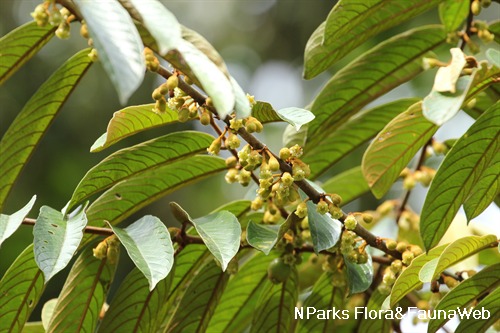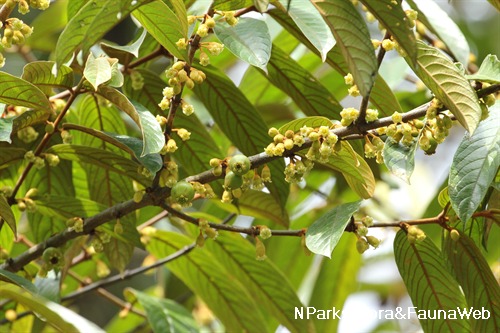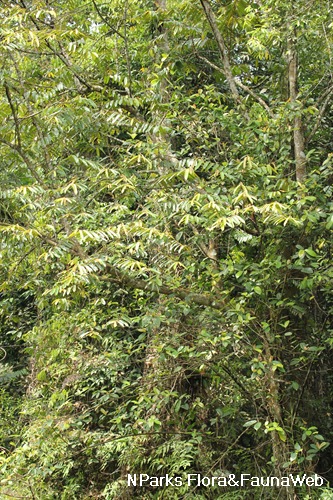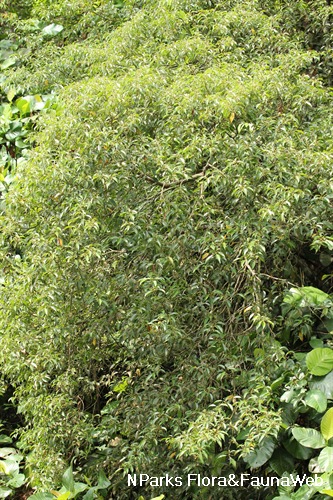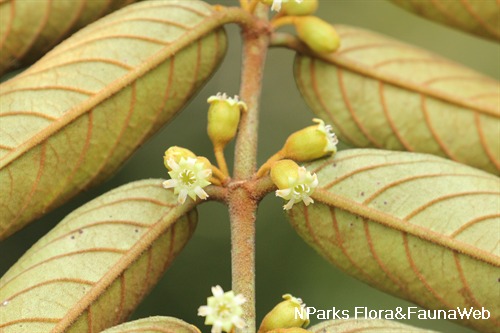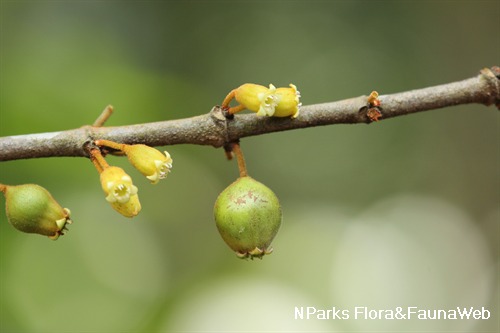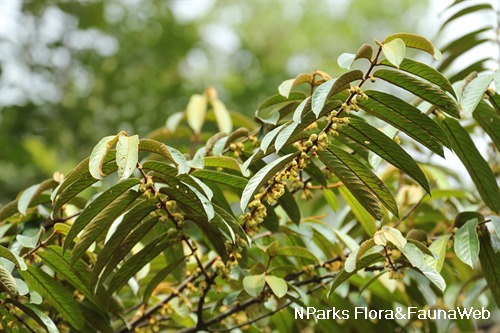
Back
Pellacalyx axillaris Korth.
| Family Name: | Rhizophoraceae |
| Common Name: | Abu-abu air, Bebuloh, Bebulu, Berbula, Buloh, Kaju baro, Kaju bulu, Kaju merah kuku, Kiramu, Mata keli, Membuloh, Menderakan, Merah bulu, Merbuloh, Piangu Jantan |
Name
Classifications and Characteristics
| Plant Division | Angiosperms (Flowering Seed Plants) (Dicotyledon) |
|---|---|
| Plant Growth Form | Tree (Medium (16m-30m)) |
| Lifespan (in Singapore) | Perennial |
| Mode of Nutrition | Autotrophic |
| Plant Shape | Irregular |
Biogeography
| Native Distribution | From Sumatra to Peninsular Malaysia, Singapore to Borneo (Brunei, East Malaysia, and Kalimantan) and to southwest Philippines (Mindanao) |
|---|---|
| Native Habitat | Terrestrial (Primary Rainforest, Secondary Rainforest, Freshwater Swamp Forest) |
| Preferred Climate Zone | Tropical |
| Local Conservation Status | Native to Singapore (Vulnerable (VU)) |
Description and Ethnobotany
| Growth Form | It is a small- to medium-sized tree with buttresses, stiff horizontal branches, and drooping leaves, growing to about 25 m tall. |
|---|---|
| Foliage | Its opposite, stalked leaves have leaf blades that are smooth, slightly toothed, drooping, oblong to drop-shaped-oblong, and 10–20 by 5–6 cm. The leaf blades are also hairy to glabrous and green above, and pubescent and rusty green below. |
| Flowers | Its stalked flowers are small and 5–10 mm long. Its flowers have small petals that are yellowish-green or white, and occasionally with thread-like protrusions at the tip. Its flowers are also borne singly or in small clusters at the branch axils. |
| Fruit | Its brown fruits are ovoid or nearly round, about 10 mm wide, and have numerous small seeds. |
| Habitat | It grows in damp localities, and along streams of lowland primary and secondary forests. It occurs locally in the Central Catchment Nature Reserve. |
| Associated Fauna | Its fruits are eaten by birds. |
| Cultivation | It can be propagated by seed. |
| Etymology | Greek pella, hide; Greek kalux, calyx, referring to the hair-covered calyx; Latin axillaris, arising from the axillary, referring to the flowers developing at the leaf axils |
| Ethnobotanical Uses | Timber & Products: Its timber is red, hard, heavy, and durable, if protected and not in contact with the ground. |
Landscaping Features
| Landscaping | This tree can be grown in wet places around ponds and waterways. Its drooping, oblong leaves also add form to the landscape. |
|---|---|
| Desirable Plant Features | Ornamental Foliage |
| Landscape Uses | General, Parks & Gardens, Small Gardens, Riverine, Pond / Lake / River |
| Thematic Landscaping | Golden Garden |
Fauna, Pollination and Dispersal
| Fauna Pollination Dispersal Associated Fauna | Bird-Attracting |
|---|---|
| Pollination Method(s) | Biotic (Fauna) |
| Seed or Spore Dispersal | Biotic (Fauna) |
Plant Care and Propagation
| Light Preference | Full Sun, Semi-Shade |
|---|---|
| Water Preference | Lots of Water, Moderate Water |
| Plant Growth Rate | Moderate |
| Rootzone Tolerance | Moist Soils, Waterlogged Soils |
| Propagation Method | Seed |
Foliar
| Foliage Retention | Evergreen |
|---|---|
| Mature Foliage Colour(s) | Green |
| Mature Foliage Texture(s) | Hairy / Hirsute |
| Foliar Type | Simple / Unifoliate |
| Foliar Arrangement Along Stem | Opposite |
| Foliar Attachment to Stem | Petiolate |
| Foliar Shape(s) | Non-Palm Foliage (Elliptical, Oblong) |
| Foliar Venation | Pinnate / Net |
Floral (Angiosperm)
| Flower & Plant Sexuality | Bisexual Flowers |
| Flower Colour(s) | White |
|---|---|
| Flower Grouping | Cluster / Inflorescence |
| Flower Location | Axillary |
| Flower Symmetry | Radial |
| Individual Flower Shape | Urceolate / Urn-shaped |
Fruit, Seed and Spore
| Mature Fruit Colour(s) | Brown |
|---|---|
| Fruit Type | Fleshy Fruit , Non-Accessory Fruit |
Image Repository
Others
| Master ID | 31204 |
|---|---|
| Species ID | 5598 |
| Flora Disclaimer | The information in this website has been compiled from reliable sources, such as reference works on medicinal plants. It is not a substitute for medical advice or treatment and NParks does not purport to provide any medical advice. Readers should always consult his/her physician before using or consuming a plant for medicinal purposes. |

